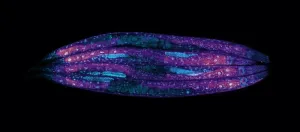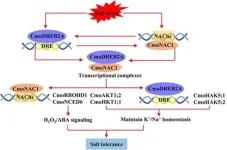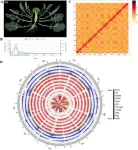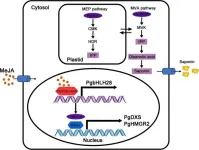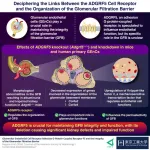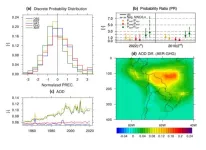(Press-News.org) HOUSTON ― Researchers at The University of Texas MD Anderson Cancer Center have demonstrated that therapeutically restoring ‘youthful’ levels of a specific subunit of the telomerase enzyme can significantly reduce the signs and symptoms of aging in preclinical models. If these findings are confirmed in clinical studies, there may be therapeutic implications for age-related diseases such as Alzheimer’s, Parkinson’s, heart disease and cancer.
The study, published today in Cell, identified a small molecule compound that restores physiological levels of telomerase reverse transcriptase (TERT), which normally is repressed with the onset of aging. Maintenance of TERT levels in aged lab models reduced cellular senescence and tissue inflammation, spurred new neuron formation with improved memory, and enhanced neuromuscular function, which increased strength and coordination.
The researchers show that TERT functions not only to extend telomeres, but also acts as a transcription factor to affect the expression of many genes directing neurogenesis, learning and memory, cellular senescence, and inflammation.
“Epigenetic repression of TERT plays a major role in the cellular decline seen at the onset of aging by regulating genes involved in learning, memory, muscle performance and inflammation,” said corresponding author Ronald DePinho, M.D., professor of Cancer Biology. "By pharmacologically restoring youthful TERT levels, we reprogrammed expression of those genes, resulting in improved cognition and muscle performance while eliminating hallmarks linked to many age-related diseases.”
Loss of TERT is connected with aging through multiple mechanisms
Aging is associated with various epigenetic changes that influence functional and physiological decline. One of the hallmarks of aging is the gradual shortening of telomeres, the chromosomal end structures that help maintain their stability. Free radicals also can modify and harm telomere sequences.
When telomeres become extremely short or modified, they trigger a continual DNA damage response, which can lead to cell senescence – a phenomenon in which cells release inflammatory factors that can cause tissue damage, prompting aging and cancer.
Telomerase is a protein complex responsible for synthesizing and extending telomeres. However, its activity is reduced over time due to the epigenetic silencing of TERT, particularly at the onset of natural aging or Alzheimer’s and other age-related diseases.
The DePinho laboratory previously showed that deactivating the TERT gene in vivo led to premature aging, which could be reversed through TERT reactivation. The researchers also observed that certain cells, such as neurons and cardiac cells, were rejuvenated without undergoing the normal cell division required to synthesize telomeres.
Their observations led them to hypothesize that TERT had other functions beyond synthesizing telomeres and that overall telomerase levels were important in the aging process. Based on these findings, the researchers, led by DePinho and first author Hong Seok Shim, Ph.D., aimed to develop a drug to restore TERT levels.
Small molecule restores TERT levels, reversing hallmarks of aging
A high-throughput screen of over 650,000 compounds identified a small-molecule TERT activating compound (TAC) that epigenetically de-represses the TERT gene and restores physiological expression present in young cells.
In preclinical models equivalent to adults over age 75, TAC treatment for six months led to new neuron formation in the hippocampus (memory center) and improved performance in cognitive tests. Additionally, there was an increase in genes involved in learning, memory and synaptic biology, consistent with TERT’s ability to interact with and control the activity of transcription factor complexes regulating diverse genes.
TAC treatment also significantly reduced inflammaging – an age-related increase in inflammatory markers linked with multiple diseases – in both blood and tissue samples and also eliminated senescent cells by repressing the p16 gene, a key senescence factor.
TAC improved neuromuscular function, coordination, grip strength and speed in these models, reversing sarcopenia – a condition under which muscle mass, strength and performance naturally worsen with advancing age.
Additionally, TAC treatment in human cell lines increased telomere synthesis with reduced DNA damage signal at telomeres and extended the proliferative potential of these cells, demonstrating the activity of TAC in ex vivo human models.
“These preclinical results are encouraging, as TAC is easily absorbed by all tissues, including the central nervous system. Yet further studies are needed to properly assess its safety and activity in long-term treatment strategies,” DePinho said. “However, our deeper understanding of the molecular mechanisms driving the aging process has uncovered viable drug targets, allowing us to explore opportunities to intercept the causes of a variety of major age-related chronic diseases.”
This study was supported by the National Institutes of Health (R01 CA084628, P30 CA016672 and S10 RR029552), the G. Harold and Leila Y Mathers Charitable Foundation and the Belfer Family Foundation Neurodegeneration Consortium. This study was a collaborative effort with Peter Schultz and Michael Bollong at the Scripps Institute. A full list of co-authors and disclosures can be found here.
Read this press release in the MD Anderson Newsroom.
- 30 -
END
As the deadly disease that came to be known as COVID-19 started spreading in late 2019, scientists rushed to answer a critical question: Who is most at risk?
They quickly recognized that a handful of characteristics — including age, smoking history, high body mass index (BMI) and the presence of other diseases such as diabetes — made people infected with the virus much more likely to become seriously ill and even die. But one suggested risk factor remains unconfirmed more than four years later: cannabis use. Evidence has emerged over time indicating both ...
Why do some people live for longer than others? The genes in our DNA sequence are important, helping avoid disease or maintain general health, but differences in our genome sequence alone explain less than 30% of the natural variance of human life expectancy.
Exploring how ageing is influenced at the molecular level could shed light on lifespan variation, but generating data at the speed, scale and quality necessary to study this in humans is unfeasible. Instead, researchers turn to worms (Caenorhabditis elegans). Humans share a lot of biology with these small creatures, who also have a large, natural variation in lifespan.
Researchers ...
Small changes in our everyday actions can trigger significant, rapid societal shifts especially when it comes to climate action. A new IIASA-led study highlights the importance of analyzing these dynamics with a comprehensive framework to harness their full potential for reducing carbon emissions.
Making small changes in how we live day-to-day can quickly create significant changes in society, especially in ways that benefit the environment. This idea is captured in the term social tipping points.
According to the authors of a new paper just published in the journal One Earth, social tipping points are crucial for speeding up efforts to reduce carbon emissions. These points occur when ...
A pivotal study has discovered a genetic synergy between pumpkin and cucumber that fortifies the latter's resilience against salinity. The research illuminates the role of the CmoDREB2A transcription factor from pumpkin, which, when interacted with cucumber's CmoNAC1, forms a regulatory loop that enhances salt tolerance. This breakthrough could be key to developing crops that thrive in saline soils, safeguarding agricultural productivity.
Soil salinity, a silent blight on global agriculture, affects an estimated 10% of the world's arable land, leading to significant crop ...
A detailed genomic study of broccoli has revealed the genetic foundations for the production of glucosinolates (GSLs), compounds celebrated for their health benefits, including anti-carcinogenic properties. By assembling a high-quality chromosome-level genome, researchers identified key genes involved in GSL biosynthesis. These findings offer critical insights for future genetic studies and the development of Brassica crops with enhanced nutritional value, paving the way for improved health benefits from these widely consumed vegetables.
Broccoli is renowned for its health benefits, primarily due to its rich glucosinolate (GSL) content, which has anti-carcinogenic ...
A cutting-edge study has pinpointed the PgbHLH28 gene as a crucial catalyst in the methyl jasmonate-induced (MeJA-induced) saponin biosynthesis in Platycodon grandiflorus. This genetic insight could significantly bolster the production of saponins, which are beneficial in combating cerebrovascular diseases and COVID-19, offering a novel therapeutic avenue in medicinal plant cultivation.
Platycodon grandiflorus, commonly known as balloon flower, is renowned for its medicinal properties, primarily due to its rich saponin content. Saponins are known for ...
Glomerulus, the fundamental filtering unit of the kidney, is an intricate network of capillaries — small blood vessels that regulate the movement of ions, water, and metabolites while maintaining impermeability to essential macromolecules such as proteins. The selectively permeable capillary wall, known as the glomerular filtration barrier (GFB), consists of three main components: glomerular endothelial cells (GEnCs), the glomerular basement membrane, and podocytes. GEnCs line the inner surface of the capillary wall and are covered by a thin layer of glycoproteins and other carbohydrate-based moieties.
Adhesion G-protein-coupled ...
(Toronto, June 21, 2024) JMIR Publications is pleased to announce that JMIR Dermatology (JMIR Derm) has been accepted for inclusion in MEDLINE, which is the U.S. National Library of Medicine's premier bibliographic database.
JMIR Dermatology was previously already indexed in PubMed, but MEDLINE is a more selective subset of PubMed, consisting of the top 5200 biomedical journals, and indexing in MEDLINE also means that articles are now also indexed with NLM Medical Subject Headings (MeSH terms) and other metadata.
Selection for MEDLINE is a result of a thorough review of the ...
(WASHINGTON, June 21, 2024) – Patients with chronic lymphocytic leukemia (CLL) and non-Hodgkin lymphomas (NHLs) who received frequent tests for immunoglobulin G (IgG) were less likely to experience severe infections compared with those who didn’t, according to a study published in Blood Advances. Moreover, only half of patients undergo such testing.
Patients with blood cancers such as CLL and NHL are at elevated risk for potentially life-threatening infections due to low blood levels of immunoglobulins — proteins ...
Earth and environmental scientists reported that as human socio-economic activities increase, greenhouse gas emissions will rise, leading to more frequent extreme weather events such as droughts and floods. However, a research team from Pohang University of Science and Technology (POSTECH) has published a study suggesting that anthropogenic greenhouse gases might actually mitigate droughts, offering a new perspective on the impact of human activities on nature.
Professor Jonghun Kam from the Division of Environmental Science and Engineering at POSTECH ...




